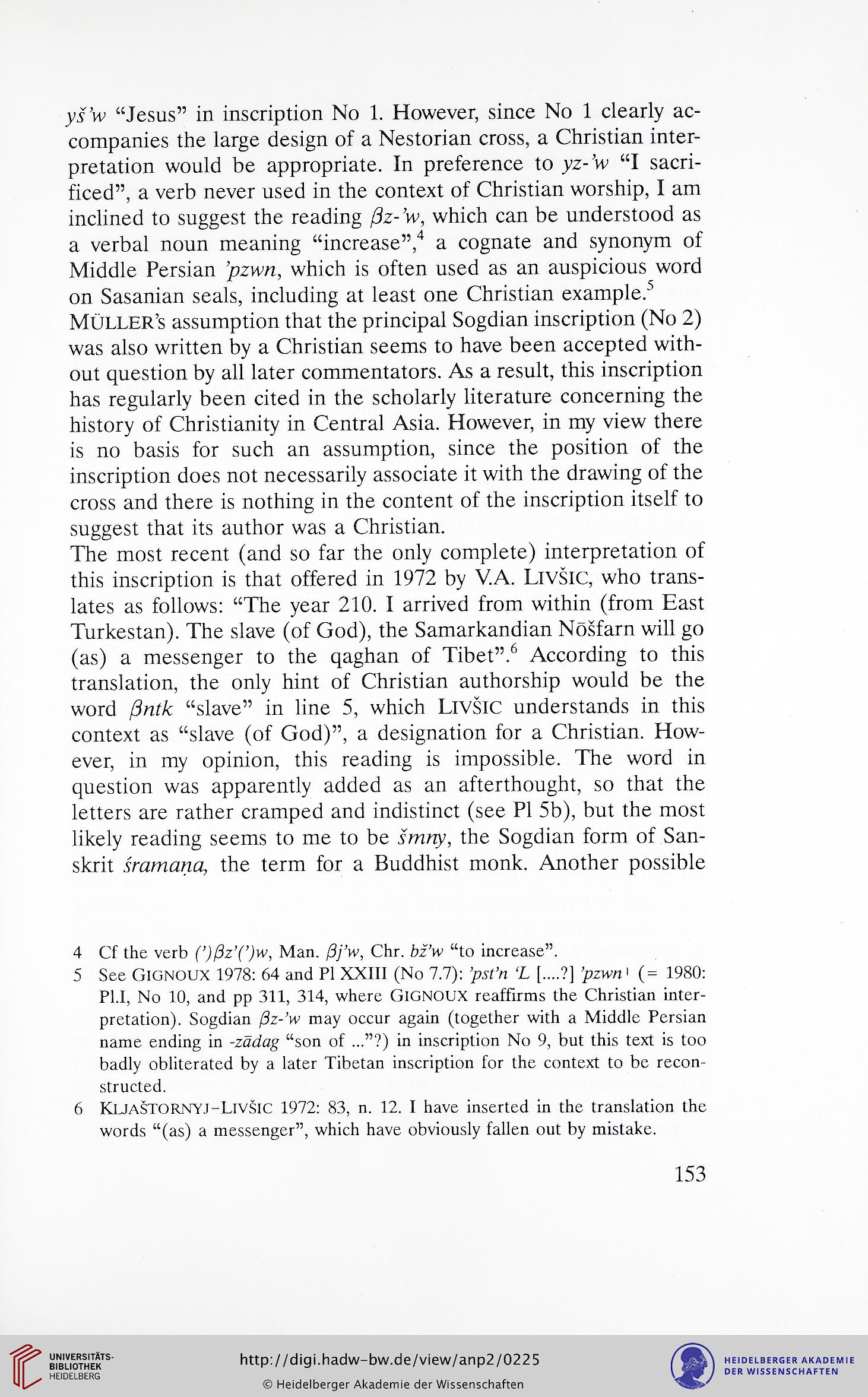yYlv "Jesus" in inscription No 1. However, since No 1 clearly ac-
companies the large design of a Nestorian cross, a Christian inter-
pretation would be appropriate. In preference to yz-lv "I sacri-
ficed", a verb never used in the context of Christian worship, I am
inclined to suggest the reading /3z-'w, which can be understood as
a verbal noun meaning "increase"^ a cognate and synonym of
Middle Persian j9zw?i, which is often used as an auspicious word
on Sasanian seals, including at least one Christian example.^
MÜLLER's assumption that the principal Sogdian inscription (No 2)
was also written by a Christian seems to have been accepted with-
out question by all later commentators. As a result, this inscription
has regularly been cited in the scholarly literature concerning the
history of Christianity in Central Asia. However, in my view there
is no basis for such an assumption, since the position of the
inscription does not necessarily associate it with the drawing of the
cross and there is nothing in the content of the inscription itself to
suggest that its author was a Christian.
The most recent (and so far the only complete) interpretation of
this inscription is that offered in 1972 by VA. LlVSlC, who trans-
lates as follows: "The year 210. I arrived from within (from East
Turkestan). The slave (of God), the Samarkandian Nösfarn will go
(as) a messenger to the qaghan of Tibet" Y According to this
translation, the only hint of Christian authorship would be the
word "slave" in line 5, which LlVSlC understands in this
context as "slave (of God)", a designation for a Christian. How-
ever, in my opinion, this reading is impossible. The word in
question was apparently added as an afterthought, so that the
letters are rather cramped and indistinct (see PI 5b), but the most
likely reading seems to me to be the Sogdian form of San-
skrit vamana, the term for a Buddhist monk. Another possible
4 Cf the verb (9/3zY9n7 Man. Chr. hz'w "to increase".
5 See GiGNOUX 1978: 64 and PI XXIII (No 7.7): 'L [....?] )9zw/C (= 1980:
Pi.I, No 10, and pp 311, 314, where GiGNOUX reaffirms the Christian inter-
pretation). Sogdian /3z-'w may occur again (together with a Middie Persian
name ending in -zö&7g "son of ..."?) in inscription No 9, but this text is too
badiy obliterated by a iater Tibetan inscription for the context to be recon-
structed.
6 KUASTORNVJ-LtVSIC 1972: 83, n. 12. I have inserted in the transiation the
words "(as) a messenger", which have obviousiy fallen out by mistake.
153
companies the large design of a Nestorian cross, a Christian inter-
pretation would be appropriate. In preference to yz-lv "I sacri-
ficed", a verb never used in the context of Christian worship, I am
inclined to suggest the reading /3z-'w, which can be understood as
a verbal noun meaning "increase"^ a cognate and synonym of
Middle Persian j9zw?i, which is often used as an auspicious word
on Sasanian seals, including at least one Christian example.^
MÜLLER's assumption that the principal Sogdian inscription (No 2)
was also written by a Christian seems to have been accepted with-
out question by all later commentators. As a result, this inscription
has regularly been cited in the scholarly literature concerning the
history of Christianity in Central Asia. However, in my view there
is no basis for such an assumption, since the position of the
inscription does not necessarily associate it with the drawing of the
cross and there is nothing in the content of the inscription itself to
suggest that its author was a Christian.
The most recent (and so far the only complete) interpretation of
this inscription is that offered in 1972 by VA. LlVSlC, who trans-
lates as follows: "The year 210. I arrived from within (from East
Turkestan). The slave (of God), the Samarkandian Nösfarn will go
(as) a messenger to the qaghan of Tibet" Y According to this
translation, the only hint of Christian authorship would be the
word "slave" in line 5, which LlVSlC understands in this
context as "slave (of God)", a designation for a Christian. How-
ever, in my opinion, this reading is impossible. The word in
question was apparently added as an afterthought, so that the
letters are rather cramped and indistinct (see PI 5b), but the most
likely reading seems to me to be the Sogdian form of San-
skrit vamana, the term for a Buddhist monk. Another possible
4 Cf the verb (9/3zY9n7 Man. Chr. hz'w "to increase".
5 See GiGNOUX 1978: 64 and PI XXIII (No 7.7): 'L [....?] )9zw/C (= 1980:
Pi.I, No 10, and pp 311, 314, where GiGNOUX reaffirms the Christian inter-
pretation). Sogdian /3z-'w may occur again (together with a Middie Persian
name ending in -zö&7g "son of ..."?) in inscription No 9, but this text is too
badiy obliterated by a iater Tibetan inscription for the context to be recon-
structed.
6 KUASTORNVJ-LtVSIC 1972: 83, n. 12. I have inserted in the transiation the
words "(as) a messenger", which have obviousiy fallen out by mistake.
153




